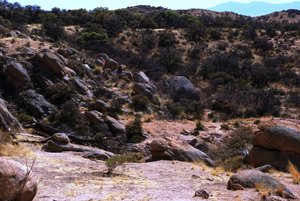Advertisement
Published: December 9th 2012

 COUNCIL ROCKS
COUNCIL ROCKS
This is a site of some spiritual mysticism still. The natural amphitheater seen in the picture is a perfect setting for serious discussion. Take Middlemarch Road to the northeast out of Tombstone for about 9 miles until you get on to Forest Circus land at the west side of the Dragoon Mountains. Take forest road 687 another 5 miles or so northwest to Council Rocks. CAPTAIN TOM JEFFORDS
Tom was born in Chautauqua, NY on Jan 1, 1832 and was raised on the shore of Chautauqua Lake. As a young man he rose to command of a steamship on Lake Erie. Folks have been calling him Captain Jeffords ever since. When his boat sank in a storm he realized that being aboard a ship was really pretty much like being in jail with the added and very real risk of drowning. In 1858 he went to work for Ben Holliday laying out the Overland Trail between Leavenworth and Denver. He spent the winter of 1859 in Taos and the following spring went prospecting in the San Juan Mountains. When the Civil War came to New Mexico in 1862 he signed on as a civilian scout for the Army and carried dispatches between Fort Thorn and Colonel Carleton in Tucson, taking time out to fight the Confederates at Val Verde. Tom states that he was an Indian trader under commission to the Dept. of the Interior at some point during the mid-1860s. After the Civil War ended Tom became the superintendent of mail in Tucson, but the ongoing Apache War was a

 CAPTAIN TOM JEFFORDS
CAPTAIN TOM JEFFORDS
Gravesite in Evergreen Cemetery in Tucson at the northwest corner of Oracle Road and Miracle Mile. Ask the friendly office lady for help in locating graves. There are many of our early notables at final rest here.vexing problem to him in that capacity. Of twenty-one people killed by Cochise along the mail route up to 1866 fourteen of them were Tom’s employees. He wanted the senseless slaughter to stop on both sides and saw no reason why both cultures could not live in peace given a little tolerance for one another. He brushed up on his language skills and learned more about the cultural differences and in 1867 was ready to ride out armed to the teeth, locate Cochise and attempt to engage him in civil discourse. It was a bold move on his part, but he got away with it and Tom became close friends with Cochise. Attacks on the mail riders stopped, but the war continued merrily on its gruesome way. By 1870 two things had happened: Cochise was growing weary of his war, and was actively pursuing terms by which to live in peace in Mexico, and had even entered negotiations for his own reservation on land in Northern New Mexico, and General Oliver Otis Howard was appointed to the post of Indian Commissioner of Arizona. Howard was ordered by President Grant to bring forth a peace treaty with Cochise and was given broad authority to do so. Tom brought the two of them, Howard and Cochise, together and they hammered out peace terms so generous that Cochise could not refuse. Cochise got a huge reservation in his homeland that extended to the border with Mexico. Tom Jeffords was to be agent on the reservation although Tom vigorously opposed that arrangement. Tom wanted to be the trader so he could clear a profit and avoid politics. There was to be no political or military intervention on the reservation. Tom was to report directly to office of the President, sort of like a cabinet official. The treaty arrangements were finalized in 1872 and the war was over. Howard thought the good citizens of Arizona would welcome the peace but he was sadly mistaken. They wanted Cochise to be held accountable and made to pay for his many misdeeds. The bureaucrats and the military were just as furious as the citizens were because they had been excluded from control. Worse was that Congress failed to appropriate funds needed to support the new reservation. Tom did the best he could to provide sustenance to his friends, but it was never enough. Cochise died of stomach cancer in 1874 and the reservation was closed down in 1876. Some of the people were taken to San Carlos, others returned to the warpath. Tom was embittered and died a recluse on his ranch near Owl Head Butte in 1914. He is buried in Evergreen Cemetery in Tucson. The photo shows Council Rocks were Cochise and his advisors agreed to accept the peace terms offered by General Howard. It was a site of some importance to them. Ceremonies were performed there, and decisions affecting the band were discussed and agreed upon there.
Advertisement
Tot: 0.25s; Tpl: 0.012s; cc: 12; qc: 44; dbt: 0.1145s; 1; m:domysql w:travelblog (10.17.0.13); sld: 1;
; mem: 1.1mb

 COUNCIL ROCKS
COUNCIL ROCKS
 CAPTAIN TOM JEFFORDS
CAPTAIN TOM JEFFORDS